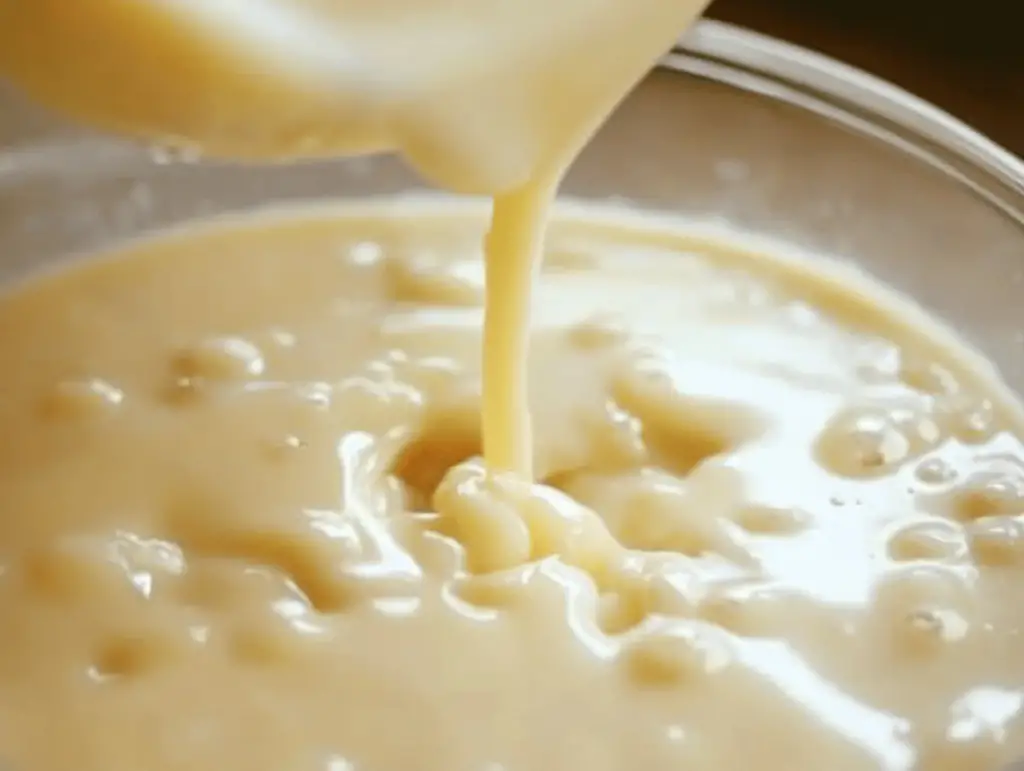Homemade condensed milk is a delightful treat that adds a rich, creamy sweetness to a variety of dishes. Whether you’re using it to elevate your desserts or to enhance your coffee, this simple recipe is not only easy to make but also a healthier alternative to store-bought versions that often contain preservatives and artificial additives. This creamy concoction primarily uses just two ingredients: milk and sugar. The beauty of homemade condensed milk lies in its versatility; you can use it in everything from baking to beverages, making it an indispensable item in your kitchen. In this article, we will explore the origins of condensed milk, break down the ingredients you’ll need, provide step-by-step instructions to create this sweet sensation, and share tips and tricks for perfecting your homemade version.
Understanding the Recipe
The origins of condensed milk can be traced back to the 19th century when it was created as a means of preserving milk. This process involves evaporating a large portion of the water content, thus concentrating the milk and its sugars. The resulting product is a thick, sweet liquid that adds creaminess and flavor to various recipes. Traditionally, condensed milk has been a staple in many cultures, particularly in desserts. From pies to cakes, it is often celebrated for its ability to enhance sweetness and texture without overpowering other flavors.
Personally, I have fond memories of using condensed milk in a range of childhood desserts, often accompanied by family gatherings and celebrations. Its comforting sweetness evokes nostalgia, making it a timeless recipe worthy of revival in today’s kitchens. This homemade version is not just a healthier alternative; it allows you to control the ingredients, ensuring quality and taste. In the following sections, we will break down each component, provide detailed instructions, and offer handy tips to help you make your very own homemade condensed milk.
Ingredient Breakdown
- 1 cup whole milk: This is the primary ingredient that gives the condensed milk its rich and creamy consistency. Whole milk contains more fat, which adds richness to the condensed milk. You can use low-fat or skim milk, but the result will be less creamy.
- 1 cup granulated sugar: Sugar is essential for sweetness and also helps to preserve the condensed milk. The sugar dissolves in the milk, creating a thick syrup as the mixture cooks down. For a lower-calorie alternative, you can experiment with sugar substitutes, but note that they may alter the taste and texture.
- 1 tbsp butter (optional): Adding butter enriches the flavor and adds a lovely creamy texture to the milk. This is optional, but I highly recommend it for an extra layer of richness.
- 1 tsp vanilla extract (optional): This ingredient enhances the flavor of the finished product, giving it an aromatic hint of vanilla. For a unique twist, consider using different extracts like almond or coconut.
Using high-quality ingredients is key to achieving the best flavor. If you have dietary restrictions, this recipe can easily accommodate them: feel free to use dairy-free milk such as almond or coconut milk with appropriate sugar substitutes. This versatility makes it suitable for anyone looking to enjoy a homemade treat.
Step-by-Step Instructions
- Gather your ingredients: Ensure you have 1 cup of whole milk, 1 cup of granulated sugar, 1 tablespoon of butter (optional), and 1 teaspoon of vanilla extract (optional).
- Mix milk and sugar: In a medium saucepan, combine the 1 cup of whole milk and 1 cup of granulated sugar. Turn the heat to medium and stir the mixture gently until all the sugar has dissolved. This step should take just a few minutes.
- Simmer the mixture: Reduce the heat to low and allow the mixture to simmer. Keep stirring occasionally to prevent the milk from scorching on the bottom of the pan. Continue this simmering process for 30-40 minutes. The goal is to reduce the liquid volume by about half and achieve a thicker consistency.
- Check for consistency: After about 30-40 minutes, you should notice that the mixture has thickened significantly. The best way to check is to dip a spoon into the mixture; it should coat the back of the spoon when it’s ready. You’re looking for a pourable but thicker consistency.
- Add flavorings: If you wish for a richer flavor, stir in 1 tablespoon of butter and 1 teaspoon of vanilla extract at this point. Mix well until the butter has melted and blended into the mixture.
- Cool and store: Once your condensed milk is ready, let it cool to room temperature before transferring it to an airtight container. Store in the refrigerator where it can last up to 2 weeks.
Follow these steps closely, and you’ll find that creating homemade condensed milk is not only easy but also incredibly rewarding. This recipe yields approximately 1 cup of sweetened condensed milk, perfect for all your culinary needs!
Variations and Customizations
One of the great advantages of homemade condensed milk is its versatility! Here are some ideas for customizing your recipe:
- Substitutes for Milk: If you want a dairy-free version, try using almond milk, coconut milk, or soy milk. Keep in mind that the flavor profile will change slightly based on the milk you use, so choose one that complements your intended use.
- Sugar Alternatives: For a healthier option, consider using natural sweeteners like honey or maple syrup, or sugar substitutes. Just be aware that the quantity may need adjusting based on sweetness preferences.
- Flavor Enhancements: Beyond vanilla extract, think about infusing your condensed milk with flavors like coffee, chocolate, or spices. Adding a pinch of cinnamon or nutmeg can deliver a warm flavor perfect for seasonal recipes.
- Texture Variations: If you prefer a thicker texture, extend the cooking time slightly. Alternatively, you could reduce the sugar to create a lighter version.
Feel free to experiment with these customizations, which can open up new possibilities for your condensed milk use, making it suitable for various dietary preferences and occasions.
Serving Suggestions
Homemade condensed milk can be served in a myriad of ways, making it a functional ingredient in many meals and snacks:
- Desserts: Use condensed milk as a key ingredient in pies, cakes, and custards. It’s especially essential in classics like tres leches cake and flan.
- Drinks: Add a spoonful of condensed milk to your coffee or tea for added sweetness and creaminess. It also makes an excellent addition to smoothies and milkshakes.
- Garnishes: Drizzle condensed milk over desserts like ice cream, pancakes, or waffles for an extra touch of sweetness.
- Occasions: This homemade treat is perfect for family gatherings, holiday celebrations, or casual lunches where desserts are desired. It can elevate simple recipes into something special.
Presentation can also enhance the overall experience, so consider pairing it with fruits, nuts, or garnishing with whipped cream for added visual appeal.
Tips for Success
To ensure your homemade condensed milk turns out perfectly, here are some essential tips:
- Stir frequently: While simmering, make sure to stir the mixture regularly to prevent it from sticking to the bottom of the pan and burning.
- Watch the heat: Keeping the heat low is crucial. Too high a temperature can cause the milk to scorch, resulting in an unpleasant flavor.
- Storing leftovers: Make sure to store your homemade condensed milk in an airtight container in the fridge. It should last up to 2 weeks. You can also freeze it in portions for longer storage; just make sure to allow it to thaw in the refrigerator before using.
By following these tips, you’ll create a delightful homemade condensed milk that shines in any recipe!
FAQs
Can I use low-fat or skim milk instead of whole milk?
Yes, you can use low-fat or skim milk, but the resulting condensed milk will be less creamy. Whole milk is recommended for the best texture and flavor.
How do I sweeten my condensed milk without using sugar?
You can try natural alternatives like honey, maple syrup, or sugar substitutes, but this may alter the flavor and texture slightly. Adjust the quantity to your taste.
Can I use this recipe for non-dairy milk?
Absolutely! Almond milk, coconut milk, or soy milk can be great substitutes. Just remember that the flavor may differ from traditional condensed milk.
How do I store condensed milk?
Store your homemade condensed milk in an airtight container in the refrigerator for up to 2 weeks. You can also freeze it for longer storage; simply thaw it in the refrigerator before use.
Can I increase the recipe to make more condensed milk?
Yes! You can easily double or triple the ingredients, but make sure to adjust your cooking times accordingly to achieve the desired consistency.
Conclusion
Homemade condensed milk is a delicious and versatile addition to any kitchen. It’s easy to make, requires just a few simple ingredients, and can be customized to suit your preferences, dietary needs, or specific dishes. By following this guide, you’ve learned about the history of condensed milk, its ingredient breakdown, and practical tips for common pitfalls. Whether you’re enhancing your desserts or sweetening your beverages, this recipe is sure to become a staple in your culinary repertoire. So why not give it a try? Share your experiences or tweaks with us through comments or social media. Enjoy the sweetness!
Print
Homemade Condensed Milk
Description
Make your own creamy homemade condensed milk with just two ingredients! Perfect for desserts, drinks, and a healthier alternative to store-bought.
Ingredients
- 1 cup whole milk: This is the primary ingredient that gives the condensed milk its rich and creamy consistency. Whole milk contains more fat, which adds richness to the condensed milk. You can use low-fat or skim milk, but the result will be less creamy.
- 1 cup granulated sugar: Sugar is essential for sweetness and also helps to preserve the condensed milk. The sugar dissolves in the milk, creating a thick syrup as the mixture cooks down. For a lower-calorie alternative, you can experiment with sugar substitutes, but note that they may alter the taste and texture.
- 1 tbsp butter (optional): Adding butter enriches the flavor and adds a lovely creamy texture to the milk. This is optional, but I highly recommend it for an extra layer of richness.
- 1 tsp vanilla extract (optional): This ingredient enhances the flavor of the finished product, giving it an aromatic hint of vanilla. For a unique twist, consider using different extracts like almond or coconut.
Instructions
- Gather your ingredients: Ensure you have 1 cup of whole milk, 1 cup of granulated sugar, 1 tablespoon of butter (optional), and 1 teaspoon of vanilla extract (optional).
- Mix milk and sugar: In a medium saucepan, combine the 1 cup of whole milk and 1 cup of granulated sugar. Turn the heat to medium and stir the mixture gently until all the sugar has dissolved. This step should take just a few minutes.
- Simmer the mixture: Reduce the heat to low and allow the mixture to simmer. Keep stirring occasionally to prevent the milk from scorching on the bottom of the pan. Continue this simmering process for 30-40 minutes. The goal is to reduce the liquid volume by about half and achieve a thicker consistency.
- Check for consistency: After about 30-40 minutes, you should notice that the mixture has thickened significantly. The best way to check is to dip a spoon into the mixture; it should coat the back of the spoon when it’s ready. You’re looking for a pourable but thicker consistency.
- Add flavorings: If you wish for a richer flavor, stir in 1 tablespoon of butter and 1 teaspoon of vanilla extract at this point. Mix well until the butter has melted and blended into the mixture.
- Cool and store: Once your condensed milk is ready, let it cool to room temperature before transferring it to an airtight container. Store in the refrigerator where it can last up to 2 weeks.
